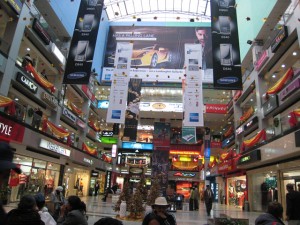 Track2Realty: Despite more than 60% of global retailers already having a presence in India, the lack of quality retail space and legislative issues have been an impediment to the spread of organized retail in the country, according to CBRE’s report, Expanding Horizons of Global Retailers in India.
Track2Realty: Despite more than 60% of global retailers already having a presence in India, the lack of quality retail space and legislative issues have been an impediment to the spread of organized retail in the country, according to CBRE’s report, Expanding Horizons of Global Retailers in India.
The expanding retail footprint of global brands in India has been a major growth driver of retail real estate in the country. In an effort to map and analyze the spread of international retailers, CBRE undertook a research study of more than 300 prominent global retailers to identify operating trends, expansion strategies, and extent of penetration across leading cities.
Brands across segments were analyzed in the luxury, premium and high-end categories; and their presence judged on the basis of standalone stores within malls as well as high streets. Since luxury brands in India have traditionally operated through boutiques in five star hotels, stores in such locations were also included in the survey.
Commenting on the findings of the report, Anshuman Magazine, Chairman and Managing Director of CBRE, South Asia, said, “India is still a largely untapped and unorganized retail market as a large number of prominent global retailers are yet to commence operations here. The country holds a considerable advantage over other emerging retail destinations due to its strong domestic consumption and low rate of market penetration by international retailers. India’s new middle class is increasingly becoming brand conscious and willing to spend on quality goods, a trend which is creating numerous business opportunities for mid-range international brands. With political and economic sentiments already showing signs of improvement, we believe this is the right time for international retailers to look at India for expansions into the region.”
The CBRE survey analysis revealed that while India has emerged as a prominent destination for retail segments like food and beverage (F&B), fashion apparel and big box/hypermarket chains, almost 40% of the global retailer base considered for the study was yet to establish a presence in the country.
Of the retailer base already present in India, nearly 80% are present in New Delhi, while the figure stands at about 70% for Mumbai and close to 50% for Bangalore—clearly elucidating the significance of these metropolitan cities as the preferred entry points for international retail chains. According to the report, this entry pattern is then typically followed by a spillover into tier II cities such as Pune, Hyderabad, Kolkata, Ahmedabad, Chandigarh and Jaipur.
US brands accounted for the bulk of retailers covered in the CBRE study, comprising 30% of the total. Most US retailers were present in the mass market F&B category; while retailers from Italy and the UK accounted for about 19% and 16%, respectively, of the total study, largely concentrated in the luxury segment.
On the flip side, the report points to the lack of quality retail real estate supply, coupled with prohibitive legislation, which has acted as an impediment to the spread of organized retail in India. Compounding the problem of limited investment-grade supply of retail space are high rentals and lack of professional mall management, all of which make for a challenging operating environment for global retailers.
It is evident, therefore, that efforts from all quarters are needed to provide global retailers with an environment comparable to that typically offered in developed retail markets. There is a need to address the concerns posed by this report, and build upon opportunities available to provide for a robust built environment for retailers venturing into India’s market places.
Anshuman Magazine adds, “Fashion accessories, F&B, and beauty and cosmetics happen to be the most penetrated retail segments in terms of the presence of global brands in India; while hypermarkets are the least penetrated, largely due to the legislative barriers imposed on the category. Most international retailers incorporated in our study have, interestingly, adopted either of the two entry routes—franchisee or joint venture—creating strong linkages with domestic operators, utilizing local market expertise to guide their business operations in India.
The report provides a reference point for global retailers planning to enter India by focusing on the entry strategies of global counterparts, in terms of preferred cities, store formats and sizes. It could also be utilized by other stakeholders, such as government authorities, to address legislative barriers responsible for the uneven development of organized retail infrastructure in most of our urban centers. Real estate developers too can benefit by targeting trends such as desirable segments of operation, preferred cities, and for planning upcoming retail projects.





